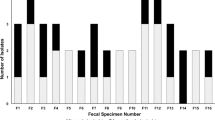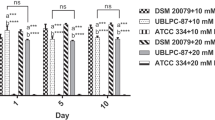Abstract
p-Cresol is a neurotoxic and nephrotoxic carcinogenic aromatic substance produced as a result of microbial fermentation in the intestine. The derivatives of p-cresol (p-cresyl sulphate or p-cresyl glucuronide) have a deleterious effect on renal failure patients undergoing hemodialysis. Human gut seems to be inhabited with a diverse microbial population capable of detoxifying many aromatic compounds. However, the knowledge on the role of gut microbes in metabolizing p-cresol is limited. Hence, the present study aims to investigate p-cresol detoxification by intestinal bacteria isolated from human feces. Three potential p-cresol tolerant isolates were selected and identified as Enterococcus faecalis strains (UTD-1, UTD-2 and UTD-3) by 16SrRNA gene sequencing. All three E. faecalis isolates decreased the p-cresol concentration (30 µg/ml) at a higher rate with extracellular extracts (2.58–9.53 µg/ml) as compared to intracellular (0.55–5.28 µg/ml) extract. These three potential isolates also exhibited tolerance to gastrointestinal conditions for up to 60 min. Added to its potential, the expression of virulent genes (esp, gelE, and cyl) was found to be suppressed when subjected to bile stress under in vitro conditions. HPLC analysis displayed transformed products from extracellular extract treated samples were comparable to the metabolite standard of the p-cresol degradation pathway. Infrared spectral analysis too showed the spectrum similarity with metabolite standard. Thus, conclusively, intestinal isolates E. faecalis (UTD-1, UTD-2 and UTD-3) might be a promising candidate for mitigating p-cresol detoxification in uremic patients.





Similar content being viewed by others
References
Evenepoel P, Meijers BK, Bammens BR, Verbeke K (2009) Uremic toxins originating from colonic microbial metabolism. Kidney Int 76:12–19
Persico AM, Napolioni V (2013) Urinary p-cresol in autism spectrum disorder. Neurotoxic Teratol 36:82–90
Poesen R, Evenepoel P, de Loor H, Kuypers D, Augustijns P, Meijers B (2016) Metabolism, protein binding, and renal clearance of microbiota-derived p-cresol in patients with CKD. Clin J Am Soc Nephrol 11:1136–1144
Poesen R, Meijers B, Evenepoel P (2013) The colon: an overlooked site for therapeutics in dialysis patients. Semin Dial 26:323–332
Ramezani A, Raj DS (2014) The gut microbiome, kidney disease, and targeted interventions. J Am Soc Nephrol 25:657–670
Koppe L, Mafra D, Fouque D (2015) Probiotics and chronic kidney disease. Kidney Int 88:958–966
Lee CT, Kuo CC, Chen YM, Hsu CY, Lee WC, Tsai YC, Ng HY, Kuo LC, Chiou TT, Yang YK, Cheng BC, Chen JB (2010) Factors associated with blood concentrations of indoxyl sulfate and p-cresol in patients undergoing peritoneal dialysis. Perit Dial Int 30:456–463
Andriamihaja M, Lan A, Beaumont M, Audebert M, Wong X, Yamada K, Yin Y, Tome D, Carrasco-Pozo C, Gotteland M, Kong X, Blachier F (2015) The deleterious metabolic and genotoxic effects of the bacterial metabolite p-cresol on colonic epithelial cells. Free Radic Biol Med 85:219–227
Brocca A, Virzi GM, de Cal M, Cantaluppi V, Ronco C (2013) Cytotoxic effects of p-cresol in renal epithelial tubular cells. Blood Purif 36:219–225
Chang MC, Chang HH, Chan CP, Yeung SY, Hsien HC, Lin BR, Yeh CY, Tseng WY, Tseng SK, Jeng JH (2014) P-Cresol affects reactive oxygen species generation, cell cycle arrest, cytotoxicity and inflammation/atherosclerosis-related modulators production in endothelial cells and mononuclear cells. PLoS ONE 9:e114446
Kamijo Y, Soma K, Kokuto M, Ohbu M, Fuke C, Ohwada T (2003) Hepatocellular injury with hyper amino transferasemia after cresol ingestion. Arch Pathol Lab Med 127:364–366
Yamamoto S, Kazama JJ, Omori K, Matsuo K, Takahashi Y, Kawamura K, Matsuto T, Watanabe H, Maruyama T, Narita I (2015) Continuous reduction of protein-bound uraemic toxins with improved oxidative stress by using the oral charcoal adsorbent AST-120 in haemodialysis patients. Sci Rep 5:14381
Guida B, Germano R, Trio R, Russo D, Memoli B, Grumetto L, Barbato F, Cataldi M (2014) Effect of short-term synbiotic treatment on plasma p-cresol levels in patients with chronic renal failure: a randomized clinical trial. Nutr Metab Cardiovasc Dis 24:1043–1049
Tingirikari JMR (2019) In-vitro prebiotic analysis of microbiota accessible pectic polysaccharides. Curr Microbiol 76:1452–1460
Sirich TL, Plummer NS, Gardner CD, Hostetter TH, Meyer TW (2014) Effect of increasing dietary fiber on plasma levels of colon-derived solutes in hemodialysis patients. Clin J Am Soc Nephrol 9:1603–1610
Tingirikari JMR (2018) Microbiota-accessible pectic poly-and oligosaccharides in gut health. Food Funct 9:5059–5073
Nowak A, Kuberski S, Libudzisz Z (2014) Probiotic lactic acid bacteria detoxify N-nitrosodimethylamine. Food Addit Contam Part A 31:1678–1687
Nowak A, Arabski M, Libudzisz Z (2008) Ability of intestinal lactic bacteria to bind or/and metabolize indole. Food Technol Biotech 46:299–304
Fang CY, Lu JR, Chen BJ, Wu C, Chen YP, Chen MJ (2014) Selection of uremic toxin-reducing probiotic in vitro and in vivo. J funct foods 7:407–415
Vanhaecke L, Vercruysse F, Boon N, Verstraete W, Cleenwerck I, De Wachter M, De Vos P, Van de Wiele T (2008) Isolation and characterization of human intestinal bacteria capable of transforming the dietary carcinogen 2-amino-1-methyl-6-phenylimidazo [4, 5-b] pyridine. Appl Environ Microbiol 74:1469–1477
Nowak A, Libudzisz Z (2007) Ability of intestinal lactic bacteria to bind or/and metabolise phenol and p-cresol. Ann Microbiol 57:329–335
Passmore IJ, Letertre MP, Bianconi Preston MD et al (2018) Para-cresol production by Clostridium difficile affects microbial diversity and membrane integrity of Gram-negative bacteria. PLoS Pathog 14:e1007191
Agrawal M, Chen RR (2011) Discovery and characterization of a xylose reductase from Zymomonas mobilis ZM4. Biotechnol Lett 33:2127–2133
Shah AA, Nawaz A, Kanwal L, Hasan F, Khan S, Badshah M (2015) Degradation of poly (ɛ-caprolactone) by a thermophilic bacterium Ralstonia sp. Strain MRL-TL isolated from hot spring. Int Biodeter Biodeg 98:35–42
Sathyabama S, Vijayabharathi R, Bruntha Devi P, Ranjith Kumar M, Priyadarisini VB (2012) Screening for probiotic properties of strains isolated from feces of various human groups. J Microbiol 50:603–612
Villa-Rodriguez E, Ibarra-Gamez C, de Los Santos-Villalobos S (2018) Extraction of high-quality RNA from Bacillus subtilis with a lysozyme pre-treatment followed by the Trizol method. J Microbiol Methods 147:14–16
Pfaffl MW, Hageleit M (2001) Validities of mRNA quantification using recombinant RNA and recombinant DNA external calibration curves in real-time RT-PCR. Biotechnol Lett 23:275–282
Sachan P, Madan S, Hussain A (2019) Isolation and screening of phenol-degrading bacteria from pulp and paper mill effluent. Appl Water Sci 9:100
Du L, Ma L, Qi F, Zheng X, Jiang C, Li A, Wan X, Liu SJ, Li S (2016) Characterization of a unique pathway for 4- cresol catabolism initiated by phosphorylation in Corynebacterium glutamicum. J Biol Chem 291:6583–6594
Tallur PN, Megadi VB, Kamanavalli CM, Ninnekar HZ (2006) Biodegradation of p-cresol by Bacillus sp. strain PHN 1. Curr Microbiol 53:529–533
Saito Y, Sato T, Nomoto K, Tsuji H (2018) Identification of phenol- and p-cresol-producing intestinal bacteria by using media supplemented with tyrosine and its metabolites. FEMS Microbiol Ecol 94:125
Nowak A, Libudzisz Z (2006) Influence of phenol, p-cresol and indole on growth and survival of intestinal lactic acid bacteria. Anaerobe 12:80–84
Al Hinai EA, Kullamethee P, Rowland IR, Swann J, Walton GW, Commane DM (2019) Modelling the role of microbial p-cresol in colorectal genotoxicity. Gut Microbes 10:398–411
Salmean YA, Segal MS, Palii SP, Dahl WJ (2015) Fiber supplementation lowers plasma p-cresol in chronic kidney disease patients. J Ren Nutr 25:316–320
Spanogiannopoulos P, Bess EN, Carmody RN, Tumbaugh PJ (2016) The microbial pharmacists within us: a metagenomic view of xenobiotic metabolism. Nat Rev Microbiol 14:273–287
Tingirikari JMR, Sarathy MV, Karthigarani AK (2019) Impact of probiotics in human health and disease treatment. In: Keservani RK, Sharma AK, Kesharwani RK (eds) Nutraceutical and functional foods in disease prevention. IGI Global, Pennsylvania, pp 35–67
Topcu A, Bulat T, Wishah R, Boyaci IH (2010) Detoxification of aflatoxin B1 and patulin by Enterococcus faecium strains. Int J Food Microbiol 139:202–205
Terada A, Bukawa W, Kan T, Mitsuoka T (2004) Effects of the consumption of heat-killed Enterococcus faecalis EC-12 preparation on microbiota and metabolic activity of the faeces in healthy adults. Microb Ecol Health Dis 16:188–194
Davila AM, Blachier F, Gotteland M, Andriamihaja M, Benetti PH, Sanz Y, Tome D (2013) Re-print of “Intestinal luminal nitrogen metabolism: role of the gut microbiota and consequences for the host. Pharmacol Res 69:114–126
Yang CF, Lee CM (2007) Enrichment, isolation and characterization of phenol-degrading Pseudomonas resinovorans strain P-1 and Brevibacillus sp. strain P-6. Int Biodeter Biodeg 59:206–210
Nueno-Palop C, Narbad A (2011) Probiotic assessment of Enterococcus faecalis CP58 isolated from human gut. Int J Food Microbiol 145:390–394
Mishra AK, Ghosh AR (2018) Characterisation of functional, Safety and Probiotic properties of Enterococcus faecalis AG5 isolated from wistar rat, demonstrating adherence to HCT 116 cells and gastrointestinal survivability. Probiotic Antimicrob Proteins 10:435–445
Parvez S, Malik KA, Ah Kang S, Kim HY (2006) Probiotics and their fermented food products are beneficial for health. J Appl Microbiol 100:1171–1185
Christoffersen TE, Jensen H, Kleiveland CR, Dorum G, Jacobsen M, Lea T (2012) In vitro comparison of commensal, probiotic and pathogenic strains of Enterococcus faecalis. Br J Nutr 108:2043–2053
Sarathy MV, Balaji S, Jagan Mohan Rao T (2020) Enterococcal infections and drug resistance mechanism. In: Siddhardha B, Dyavaiah M, Syed A (eds) Model organisms for microbial pathogenesis, biofilm formation and antimicrobial drug discovery. Springer, Singapore, pp 131–158
Hofmann AF (1989) Enterohepatic circulation of bile acids. In: Schultz SG, Forte JG, Rauner BB (eds) Handbook of physiology. Section 6: the gastrointestinal system, salivary, gastric, pancreatic, and hepatobiliary secretion, Am Physiol Soc, Bethesda, pp 567–596
Mubarak Z, Soraya C (2018) The acid tolerance response and pH adaptation of Enterococcus faecalis in extract of lime Citrus aurantiifolia from Aceh Indonesia. Research 7:287
Zhang X, Bierschenk D, Top J, Anastasiou I, Bonten MJ, Willems RJ, Van Schaik W (2013) Functional genomic analysis of bile salt resistance in Enterococcus faecium. BMC genomics 14:299
Batchelor HK, Marriott JF (2015) Paediatric pharmacokinetics: key considerations. Br J Clin Pharmacol 79:395–404
Hwang IY, Lim SK, Ku HO, Park CK, Jung SC, Park YH, Nam HM (2011) Occurrence of virulence determinants in fecal Enterococcus faecalis isolated from pigs and chickens in Korea. J Microbiol Biotechnol 21:1352–1355
Acknowledgements
All the authors gratefully acknowledge to DST-PURSE PHASE-II Programme, India, for providing financial support.
Author information
Authors and Affiliations
Corresponding author
Ethics declarations
Conflict of interest
The authors declare that they have no conflict of interest.
Additional information
Publisher's Note
Springer Nature remains neutral with regard to jurisdictional claims in published maps and institutional affiliations.
Electronic supplementary material
Below is the link to the electronic supplementary material.
Rights and permissions
About this article
Cite this article
Vijayasarathy, M., Kiran, G.K., Balaji, S. et al. In Vitro Detoxification Studies of p-Cresol by Intestinal Bacteria Isolated from Human Feces. Curr Microbiol 77, 3000–3012 (2020). https://doi.org/10.1007/s00284-020-02124-x
Received:
Accepted:
Published:
Issue Date:
DOI: https://doi.org/10.1007/s00284-020-02124-x




